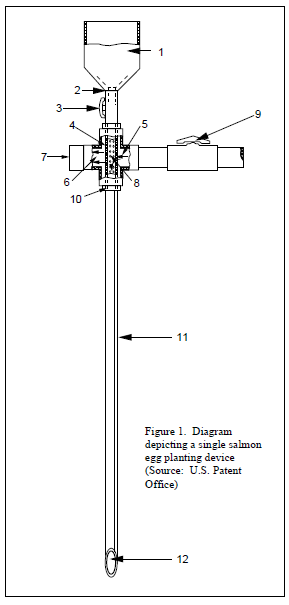There is an opportunity to alleviate salmon losses during drought years when low river flows and warm water can cause mortality of incubating salmon eggs. The technique was previously used in Alaska that proved to be highly successful in populating under-utilized salmon streams: hydraulic injection of eyed salmon eggs obtained from hatcheries into the natural environment of streams and rivers. It is currently used in some streams in Oregon. Last year, prompted by concerns over anticipated losses of salmon eggs because of warm water, this technique was proposed for the upper Sacramento River and Battle Creek using Coleman Hatchery eggs but was not implemented due to a variety of concerns by the fishery resource agencies. Prominent among those concerns: 1) the technique has never been implemented in California, and 2) it could interfere with the genetic integrity of fall-run salmon in the Central Valley. On this latter concern, as pointed out by Tom Cannon in a prior blog entry, “Studies have shown that [fall-run Chinook] populations across the Valley are homogeneous, with little or no genetic diversity, and consist mainly of hatchery fish and some natural offspring of hatchery fish. There really are no viable “wild” Fall Run Chinook populations left in the Central Valley.”1 Additionally, hatcheries such as Coleman Hatchery purposefully breed natural-origin salmon with hatchery-origin salmon to prevent domestication of hatchery stocks (USFWS 2011).
The egg injection concept is as follows. Using facilities at a Central Valley salmon hatchery (e.g., Coleman Hatchery on Battle Creek or Feather River Hatchery), incubate surplus fall-run Chinook eggs in chilled, sterilized water to eyed stage then hydraulically inject the eggs back into the river after water temperatures have naturally cooled to tolerable levels in November or December. The eggs would be injected using an egg planting device invented by Tod Jones and described by his patent and Vogel (2003) (Figure 1).
One objective of this approach would be to partially compensate for the anticipated loss of fall-run salmon production during October caused by deleterious water temperatures in drought years. The intent is to repopulate the river with fertilized salmon eggs originating from a hatchery but hatched and reared in the natural riverine environment. Specifically, the intent would be to reseed the river with fertilized salmon eggs to boost future ocean sport and commercial salmon catch, in-river sport catch, and salmon runs returning to spawning grounds. If properly implemented, the survival of salmon eggs implanted in the river can greatly exceed that of naturally-spawned eggs (Tod Jones, pers. comm., September 8, 2014).
In addition, this approach would help retain the diversity in spawning timing from the salmon lost during the October spawn in warm, drought years. Because salmon primarily return as three-year-old fish to spawn, loss of a major portion of the early-spawning component of the fall-run Chinook could propagate forward in time such that many future generations of salmon may not possess the early spawning characteristics. If actions are not taken to preserve the early spawning component of the fall run, the run three years hence would not only be expected to be depressed but also lack many of the October-spawning fish. Loss of the October spawning component of the fall run will unfavorably truncate the usual timing of spawning to those fish spawning in November and December. Retaining the early spawning component of the fall run will increase resilience of future salmon runs approximately every three years thereafter.
Furthermore, this project could increase the survival of juvenile salmon outmigration. Because fall-run salmon eggs laid during October incubate and hatch earlier than eggs laid later in November and December, the earlier fish are anticipated to emigrate sooner. If the drought persists, an earlier outmigration of salmon would be beneficial because riverine and Delta conditions will be inhospitable for salmon in the spring. For example, the present-day management strategy of Coleman Hatchery is to rear and release the normal smolt production in April when riverine and Delta conditions are more favorable as compared to May when the hatchery previously released salmon during the 1980s.
The egg injection technique has great promise for salmon restoration. It could save many salmon during drought years and could be an invaluable technique to rapidly populate new, presently unused areas envisioned for salmon restoration. It has now been 12 years since this project was proposed for implementation in California: Vogel (2003). It would certainly be preferable to doing nothing and could have potentially saved millions of salmon eggs in the fall of 2014 when conditions in some Central Valley rivers were lethally warm. Hopefully, a pilot demonstration of the egg injection project may be implemented in the fall of 2015 in the Feather River thanks to the cooperation of the California Department of Fish and Wildlife and, depending on the outcome, a larger-scale project in 2016.
References
- U.S. Fish and Wildlife Service. 2011. Biological assessment of artificial propagation at Coleman National Fish Hatchery and Livingston Stone National Fish Hatchery: program description and incidental take of Chinook salmon and steelhead. July 2011. 372 p.
- Vogel, D.A. 2003. Evaluation of a proposal for hydraulic salmonid egg deposition. Report prepared for the U.S. Bureau of Reclamation. Natural Resource Scientists, Inc. October 2003. 36 p.

